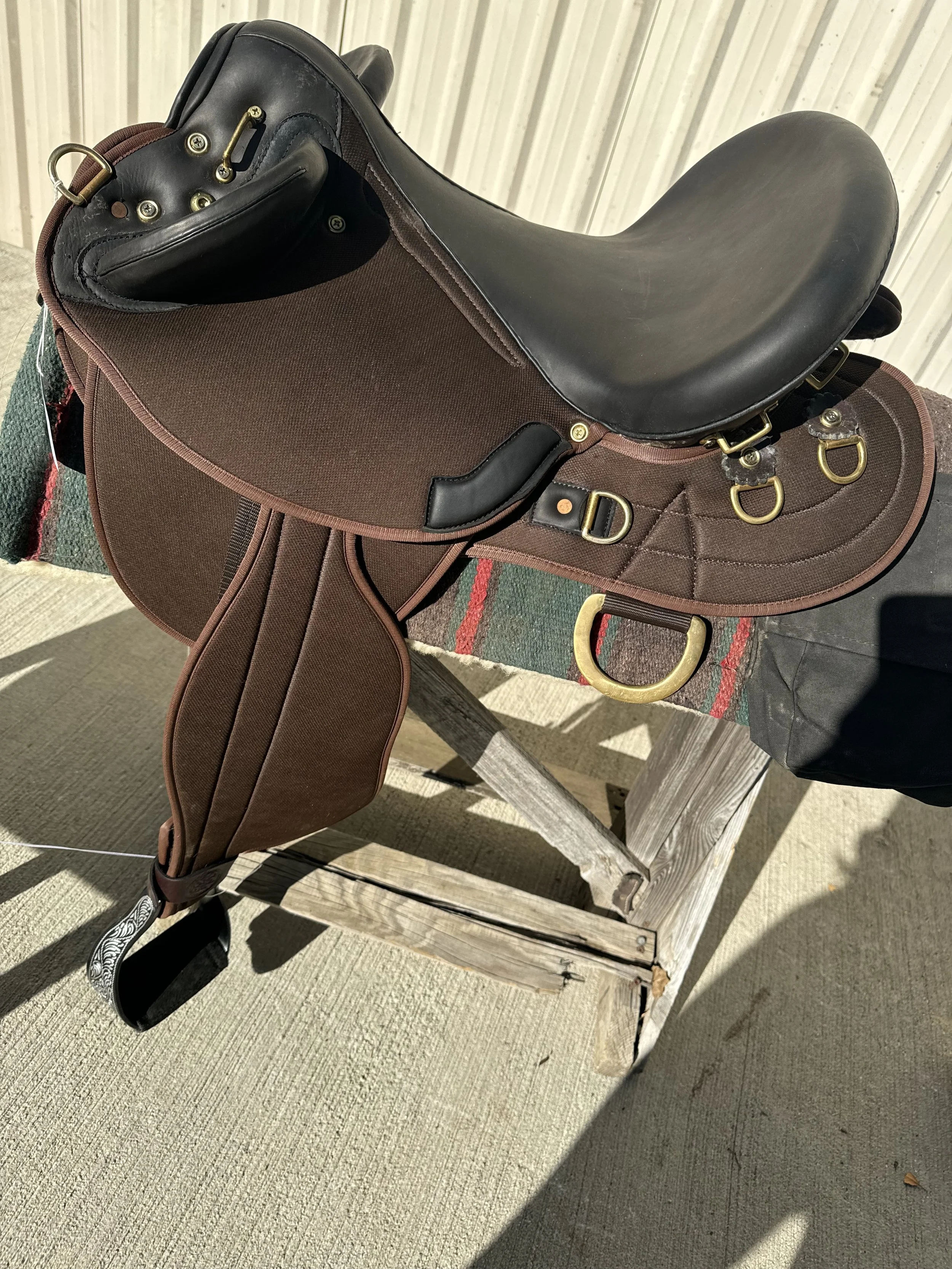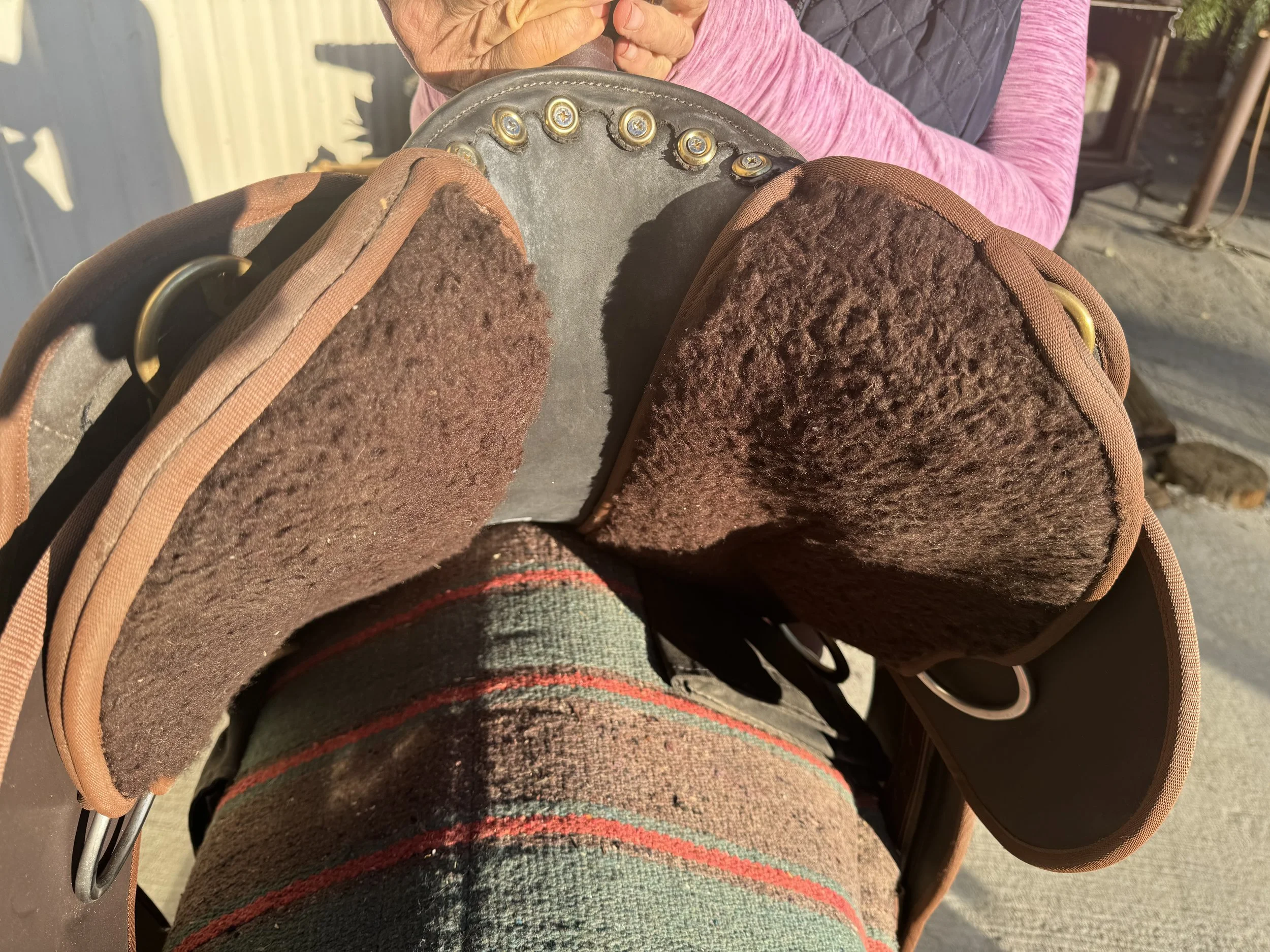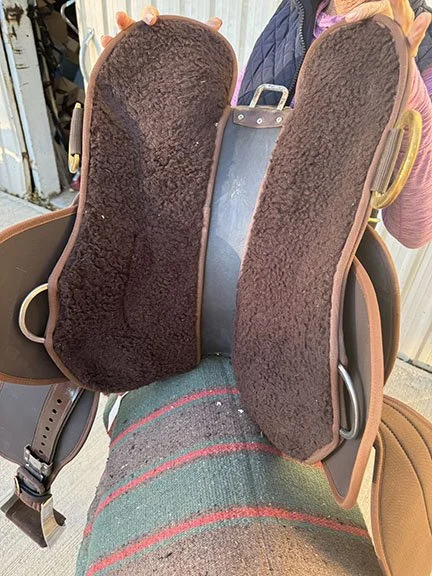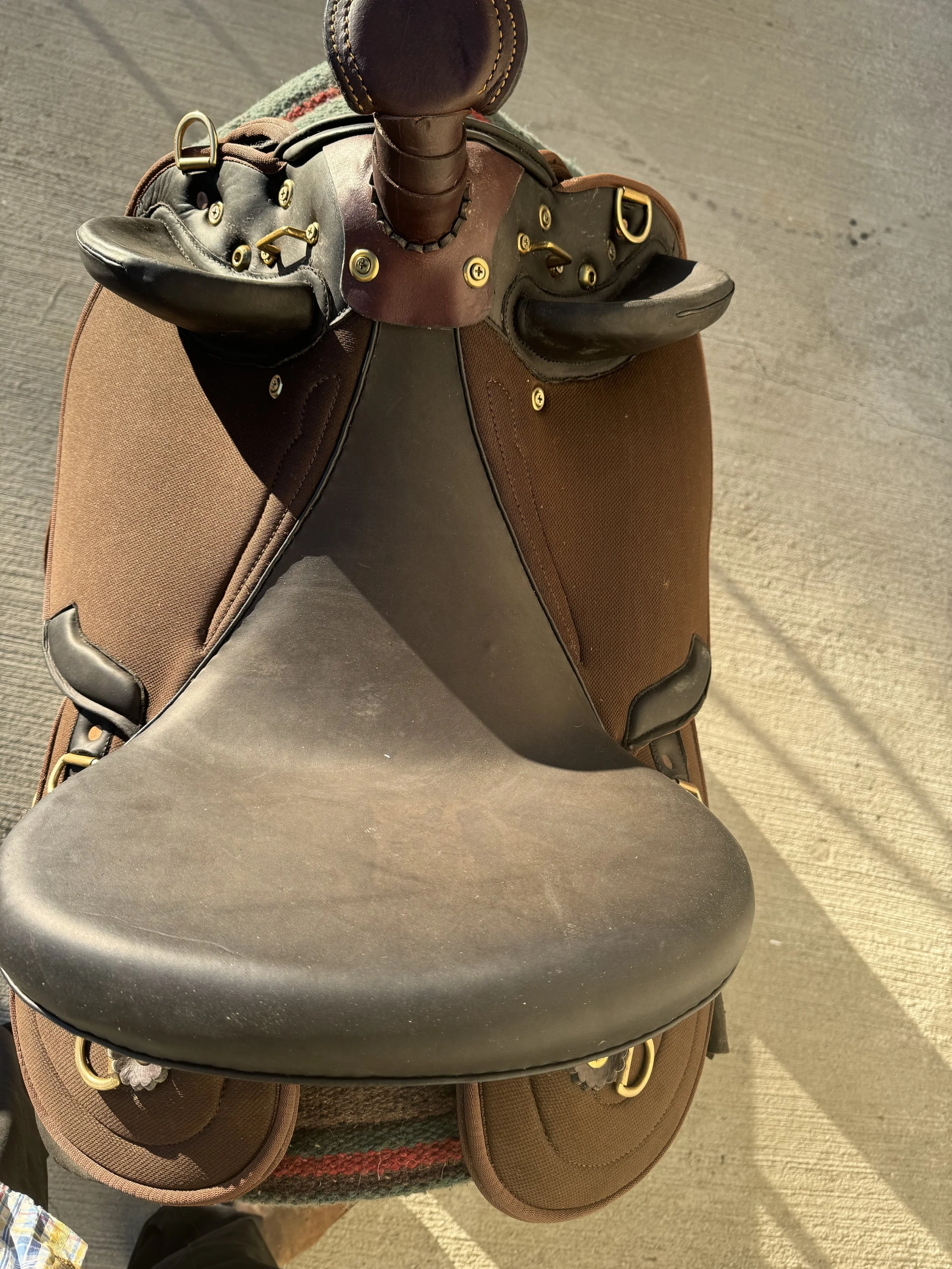The Pat Fish Poley Saddle for riders 300lbs and up
The PAT FISH POLEY is a remarkable new saddle designed by COLIN DANGAARD for riders who weigh 300 lbs or more.
The saddle’s creation was inspired by Pat Fish, the first web master for COLINDANGAARD.COM. Pat rides her 16.2-hand mule Tobe where other riders on horses might fear to go. Now, as she explains, she has a saddle that has changed her life:
“I have never ridden a saddle more comfortable or secure. It is unbelievable. And Tobe loves it. I can drop him down steep hills, and he does not try and crab to the side to escape pressure on this withers. He goes straight down. This saddle gives me the connection with him that means I can adventure in the mountains without fear. I am back riding now after falling a year ago, and having vertebrae fused in my back. I requested a custom saddle from Colin Dangaard because I need the security against falling that the poleys have always provided the riders in the Australian outback. I want to feel confident with the saddle, my mule, and myself. This saddle is a life-changer for me.”
The saddle has 5 1/2” knee pads in the front AND 5 1/2” thigh pads at the back to really lock in a rider. The seat for Pat’s saddle is 22”, but The PAT FISH POLEY can be built in sizes from 2O” to 23”.
Contrary to popular belief weight is NOT THE MOST CRITICAL FACTOR IN HORSE RIDING. For almost 2,000 years horses have gone into battle carrying 300 lbs. The warhorses of the Knights of Old carried 400 lbs.
Colin Dangaard fitted the US Special Forces in Afghanistan with saddles, and those horses also carried 300 lbs. The smaller the horse, the more weight it can carry compared with weight of horse.
Fit of saddle is the most important factor when it comes to what a horse or mule can carry. The PAT FISH POLEY has 600 square inches of bearing surface. A regular dressage saddle in the same seat size has around 200 square inches, depending on the model. For a 300 lb rider, this gives a 22” PAT FISH POLEY a PSI of .50 — pounds per square inch.
Although there are no firm standard on PSI it is generally considered that 1.25 is in the red zone for carrying capacity of horses or mules. But to reach the lowest PSI possible for the bearing surface, it is vital the saddle fit perfectly. If only half of the surface is bearing correctly, PSI will double.
An even sweat pattern will indicate even pressure. But the ultimate test is horse behavior and palpitating the back after a ride long enough to produce sweat. A saddle sore horse will always DIP under finger pressure. He will also not stand still.
Under saddle he will take small steps to protect his withers. If the pain is too great, and the rider has taken no action, the horse will do all he has left — buck off the rider.
Colors brown or black or a combination. The horn is optional. Because Pat Fish has limited upper body strength, she invented a crane mounted on the back of her pickup to load her saddle on her 16.2 hand mule Tobe. Pat is going to ride no matter what!!!!
The PAT FISH POLEY is a remarkable new saddle designed by COLIN DANGAARD for riders who weigh 300 lbs or more.
The saddle’s creation was inspired by Pat Fish, the first web master for COLINDANGAARD.COM. Pat rides her 16.2-hand mule Tobe where other riders on horses might fear to go. Now, as she explains, she has a saddle that has changed her life:
“I have never ridden a saddle more comfortable or secure. It is unbelievable. And Tobe loves it. I can drop him down steep hills, and he does not try and crab to the side to escape pressure on this withers. He goes straight down. This saddle gives me the connection with him that means I can adventure in the mountains without fear. I am back riding now after falling a year ago, and having vertebrae fused in my back. I requested a custom saddle from Colin Dangaard because I need the security against falling that the poleys have always provided the riders in the Australian outback. I want to feel confident with the saddle, my mule, and myself. This saddle is a life-changer for me.”
The saddle has 5 1/2” knee pads in the front AND 5 1/2” thigh pads at the back to really lock in a rider. The seat for Pat’s saddle is 22”, but The PAT FISH POLEY can be built in sizes from 2O” to 23”.
Contrary to popular belief weight is NOT THE MOST CRITICAL FACTOR IN HORSE RIDING. For almost 2,000 years horses have gone into battle carrying 300 lbs. The warhorses of the Knights of Old carried 400 lbs.
Colin Dangaard fitted the US Special Forces in Afghanistan with saddles, and those horses also carried 300 lbs. The smaller the horse, the more weight it can carry compared with weight of horse.
Fit of saddle is the most important factor when it comes to what a horse or mule can carry. The PAT FISH POLEY has 600 square inches of bearing surface. A regular dressage saddle in the same seat size has around 200 square inches, depending on the model. For a 300 lb rider, this gives a 22” PAT FISH POLEY a PSI of .50 — pounds per square inch.
Although there are no firm standard on PSI it is generally considered that 1.25 is in the red zone for carrying capacity of horses or mules. But to reach the lowest PSI possible for the bearing surface, it is vital the saddle fit perfectly. If only half of the surface is bearing correctly, PSI will double.
An even sweat pattern will indicate even pressure. But the ultimate test is horse behavior and palpitating the back after a ride long enough to produce sweat. A saddle sore horse will always DIP under finger pressure. He will also not stand still.
Under saddle he will take small steps to protect his withers. If the pain is too great, and the rider has taken no action, the horse will do all he has left — buck off the rider.
Colors brown or black or a combination. The horn is optional. Because Pat Fish has limited upper body strength, she invented a crane mounted on the back of her pickup to load her saddle on her 16.2 hand mule Tobe. Pat is going to ride no matter what!!!!
The PAT FISH POLEY is a remarkable new saddle designed by COLIN DANGAARD for riders who weigh 300 lbs or more.
The saddle’s creation was inspired by Pat Fish, the first web master for COLINDANGAARD.COM. Pat rides her 16.2-hand mule Tobe where other riders on horses might fear to go. Now, as she explains, she has a saddle that has changed her life:
“I have never ridden a saddle more comfortable or secure. It is unbelievable. And Tobe loves it. I can drop him down steep hills, and he does not try and crab to the side to escape pressure on this withers. He goes straight down. This saddle gives me the connection with him that means I can adventure in the mountains without fear. I am back riding now after falling a year ago, and having vertebrae fused in my back. I requested a custom saddle from Colin Dangaard because I need the security against falling that the poleys have always provided the riders in the Australian outback. I want to feel confident with the saddle, my mule, and myself. This saddle is a life-changer for me.”
The saddle has 5 1/2” knee pads in the front AND 5 1/2” thigh pads at the back to really lock in a rider. The seat for Pat’s saddle is 22”, but The PAT FISH POLEY can be built in sizes from 2O” to 23”.
Contrary to popular belief weight is NOT THE MOST CRITICAL FACTOR IN HORSE RIDING. For almost 2,000 years horses have gone into battle carrying 300 lbs. The warhorses of the Knights of Old carried 400 lbs.
Colin Dangaard fitted the US Special Forces in Afghanistan with saddles, and those horses also carried 300 lbs. The smaller the horse, the more weight it can carry compared with weight of horse.
Fit of saddle is the most important factor when it comes to what a horse or mule can carry. The PAT FISH POLEY has 600 square inches of bearing surface. A regular dressage saddle in the same seat size has around 200 square inches, depending on the model. For a 300 lb rider, this gives a 22” PAT FISH POLEY a PSI of .50 — pounds per square inch.
Although there are no firm standard on PSI it is generally considered that 1.25 is in the red zone for carrying capacity of horses or mules. But to reach the lowest PSI possible for the bearing surface, it is vital the saddle fit perfectly. If only half of the surface is bearing correctly, PSI will double.
An even sweat pattern will indicate even pressure. But the ultimate test is horse behavior and palpitating the back after a ride long enough to produce sweat. A saddle sore horse will always DIP under finger pressure. He will also not stand still.
Under saddle he will take small steps to protect his withers. If the pain is too great, and the rider has taken no action, the horse will do all he has left — buck off the rider.
Colors brown or black or a combination. The horn is optional. Because Pat Fish has limited upper body strength, she invented a crane mounted on the back of her pickup to load her saddle on her 16.2 hand mule Tobe. Pat is going to ride no matter what!!!!

























